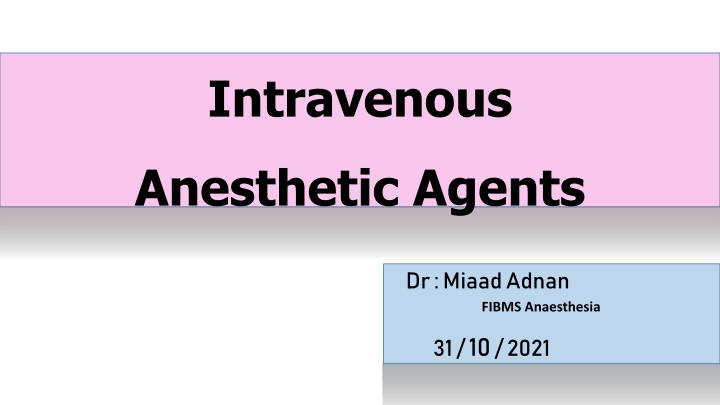
Intravenous Anesthetic Agents Overview
Explore the use of intravenous anesthetic agents such as Barbiturates and Benzodiazepines in anesthesia practice. Learn about their indications, adverse effects, and contraindications. Discover how these drugs are used for induction, maintenance, and treatment purposes in various medical settings.
Download Presentation

Please find below an Image/Link to download the presentation.
The content on the website is provided AS IS for your information and personal use only. It may not be sold, licensed, or shared on other websites without obtaining consent from the author. If you encounter any issues during the download, it is possible that the publisher has removed the file from their server.
You are allowed to download the files provided on this website for personal or commercial use, subject to the condition that they are used lawfully. All files are the property of their respective owners.
The content on the website is provided AS IS for your information and personal use only. It may not be sold, licensed, or shared on other websites without obtaining consent from the author.
E N D
Presentation Transcript
Intravenous Anesthetic Agents Dr: MiaadAdnan FIBMS Anaesthesia 31 / 10/ 2021
1 Intravenous Anesthetics Miscellaneous Miscellaneous drugs drugs Opioids Opioids Barbiturates Barbiturates Benzodiazepines Benzodiazepines
2 Barbiturates (thiopenton or thiopental) Indications : 1. Induction of anesthesia 2. Maintenance of anesthesia (but has cumulative effects) 3. Treatment of status epilepticus 4. Reduction of intra-cranial pressure (ICP)
3 Barbiturates (thiopenton or thiopental) Adverse effects: 1. Hypotension 2. Respiratory depression 3. Tissue necrosis (if injected extra-vascular) 4. Laryngospasm 5. Bronchospasm (avoid in asthma) 6. Thrombophlibitis (less common in 2.5% conc.)
4 Barbiturates (thiopenton or thiopental) Adverse effects: 7 - Allergic reactions 1 in 14000-20000 8 - Intra-arterial injection (lead to sever vasospasm and sever pain it may lead to gangrene of the limb, treatment by keeping the cannula in and inject papeverine 20 mg, heparin and fluid, using 2.5% conc. Is safer)
5 Barbiturates (thiopenton or thiopental) Contra indications: 1. Airway obstruction (epiglottis or pharyngeal tumours) 2. Porphyria 3. Previous hypersensitivity to this drug
6 Benzodiazepines (Diazepam, Midazolam) Indications: 1. Sedation during regional anesthesia 2. Radiological procedures (children, anxious persons) 3. Endoscopy 4. ICU 5. Supplementation to general anesthesia 6. Amnesia 7. Status epilepticus
7 Benzodiazepines (Diazepam, Midazolam) Adverse effects: 1. Prolong duration (diazepam) 2. Painful on injection (diazepam) 3. Hypotension if used with other agents like opioids 4. Respiratory depression in over dosage Contraindications: Early pregnancy (teratogenic effect)
8 Opioids Opioids Agonist Morphine, Pethidine, Tramadol Fentanyl & Al, Remi, Su (fentanil) Agonist-Antagonist Pentazocine, Nalburphine Antagonist Nalaxone
9 Opioids : Indications : 1. Provision of analgesia before or after surgery 2. Induction of anesthesia and maintenance of anesthesia in patients with severe cardiac dysfunction 3. Inhibition of reflex sympathetic nervous system activity 4. Provide post operative analgesia by injecting it to the subarachnoid or epidural space
10 Opioids : Adverse effects : 1 - On cardiovascular system: 1. Orthostatic hypotension (decreased sympathetic nervous system tone to peripheral veins) 2. Release of histamine (Morphine) 3. Bradycardia (Sufentanil)
11 Opioids : Adverse effects : 2 - On Ventilation : 1. Increase resting PaCo2 2. Decrease of responsiveness to the ventilatory stimulation of CO2 3. Decreased rate of breathing but tidal volume is often increased 4. Spasm of thoraco-abdominal muscles Stiff chest syndrome
12 Opioids : Adverse effects : 2 - On CNS : 1. Miosis 2. Stimulation of Dopamine receptors in the chemoreceptor trigger zone which cause nausea and vomiting 3. Addiction
13 Opioids : Adverse effects : 3 - On GIT & Urinary Bladder : Enhancement of bladder sphincter tone which lead to urine retention Decrease peristalsis movement of bowel Increase the tone of the pyloric sphincter which lead to delayed gastric emptying Spasm of biliary smooth muscles which leads to pain also spasm of the sphincter of Oddi
14 Morphine (10, 15mg) Can be Administered by variety of routes Has active metabolites Risk of accumulation in patient with renal impairment Avoid in asthma (histamine release) Pethidine (100mg) Shorter acting Its metabolites has long half life with risk of accumulation in patient with renal impairment, also the metabolites are neurotoxic and result in grand mal seizures Avoid in patient with history of epilepsy
15 Tramadol (100mg) Analgesic efficacy around one tenth that of morphine Avoid in patient with history of epilepsy Useful for elderly Useful For Patient-Controlled Analgesia (PCA) Fentanyl (100 g ) Very potent opioid used primarily for intra-operative analgesia Useful drug for PCA Cause respiratory depression
16 Alfentanil (100 g ) : Ultra short-acting potent opioid used for intra- operative analgesia Limited use in the post operative period Cause respiratory depression Sufentanil : Is closely related in structure to fentanyl 5-10 times more potent than fentanyl and slightly shorter duration Remifentanil : Ultra short acting opioids The duration of action is short with no residual effects
17 Opioids : Agonist-Antagonist Those drugs have limited analgesic properties (ceiling effect) above which increasing doses do not produce additional anesthesia, they usually used for treatment of addiction
18 Opioids : Antagonist : Is used as a short acting opioid antagonist because of its short duration of action opioid terminated depression may return when effect of Nalaxone have terminated Nalaxone may precipitate the sympathetic drive of unrelieved pain (tachycardia, hypertension, arrhythmias----- etc.)
19 Opioids : Naloxone Naloxone competes with opioids at the mu, delta, kappa and sigma receptors. Ampules of 0.02, 0.4 and 1 mg/ml. Peak effect 1-2 min. Duration of action 30-60 min. Used in perioperative surgical patients with excessive sedation or respiratory sedation secondary to opioids.
20 Opioids : Naloxone Given in small incremental doses. High doses of naloxone will result in sudden reversal of analgesic effects leading to abrupt return of pain resulting in hypertension, tachycardia, pulmonary edema, ventricular dysrhythmias and cardiac arrests. If sedation or respiratory depression recurs, continuous infusion of 3-10 mcg/kg/hour of naloxone is required.
21 Miscellaneous drugs Ketamine hydrochloride Propofol Etomidate
22 Miscellaneous drugs : 1 - Propofol : Physical and chemical properties Emulsion consists of : 1% propofol 10mg/ml 10% soyabean oil. 2.25 %glycerol 1.2% purified egg phosphatide.
23 Miscellaneous drugs : 1 - Propofol : Physical and chemical properties So Propofol is a highly lipid soluble oil that s combined with glycerol, egg, and soya bean oil for IV administration. It s appearance is similar to that of a 2% milk. It has a pH of 7 and is supplied in 20 ml ampoules with a concentration of 10 mg/ml. Neither precipitates histamine release nor triggers malignant hyperthermia. Has no effects on muscle relaxants. Associated with low incidence of nausea & vomiting.
24 Miscellaneous drugs : Effects on Organ systems : A- Cerebral : 1 - Propofol : Decreases cerebral blood flow and intracranial pressure. Propofol has antiemetic, antipruritic, and anticonvulsant properties. B- Cardiovascular: Decrease in arterial blood pressure secondary to a drop in systemic vascular resistance, contractility, and preload. Hypotension is more pronounced than with thiopental. Propofol markedly impairs the normal arterial baroreflex response to hypotension.
25 Miscellaneous drugs : Effects on Organ systems : C- Respiratory: 1 - Propofol : Propofol causes profound respiratory depression. Propofol induced depression of upper airway reflexes exceeds that of thiopental. D- Venous irritation: Pain on injection is more common than with thiopental esp. If given in a small vein in the hand. To solve this problem: 1. small doze of lidocaine with propofol. 2. administering propofol through a fast flowing more proximal IV catheter.
26 Miscellaneous drugs : A - Indications : 2- Ketamine hydrochloride : 1. 2. 3. 4. 5. 6. B - Adverse effects : 1. Emergence delirium, nightmares and hallucinations 2. Hypertension and tachycardia 3. Prolong recovery 4. Salivation 5. Increase intra-cranial pressure Shocked patient Pediatric anesthesia Difficult locations (at accident site, wars) Analgesia And sedation (wound dressing change) In ICU In developing countries (where anesthesia equipment's and trained staff are in short supply)
27 Miscellaneous drugs : 2- Ketamine hydrochloride : It s a dissociative anesthetic agent. by dissociative we mean that the patient is unconscious but appears awake and doesn t feel pain. It has anesthetic and analgesic effect
28 Miscellaneous drugs : 2- Ketamine hydrochloride : Physical and chemical properties chemically related to the psychotropic drug ( e.g. phencyclidine). Water soluble, and 10x more lipid soluble than thiopental. pH=3.5 - 5.5
29 Miscellaneous drugs : 2- Ketamine hydrochloride : METABOLISM It has a rapid absorption and distribution to the vessel rich groups like THIOPENTAL Hepatic metabolism is required for elimination <5% excreted unchanged in urine
30 Miscellaneous drugs : Mechanism of action 2- Ketamine hydrochloride : There are 3 theories explains the MOA of ketamine : 1 N-methyl aspartate receptor theory NMA receptors may represent a subgroup of the sigma opiate receptors (the PCP site) that blocks spinal pain reflexes 2 Opiate receptor theory : Ketamine may have some affinity for opiate receptors but it s effect can t be reversed with naloxone. 3- Miscellaneous receptor theory : It reacts with muscarinic, cholinergic and serotonergic receptors. Ketamine is a potent analgesic at subanesthetic plasma concentrations. It has a wide margin of safety ( up to 10x the usual dose )
31 Miscellaneous drugs : Pharmacodynamics : 1 CNS : 2- Ketamine hydrochloride : 1. ketamine increases cerebral oxygen consumption, cerebral blood flow, and intracranial pressure 2- generalized increase in the muscle tone and purposful movements. 3- Unpleasant dreams, hallucinations or frank delirium (esp. females & large dose of ketamine). incidence of delirium in 15-35 year old Pts is approx. 20%
32 Miscellaneous drugs : Pharmacodynamics : 2 Respiratory system: 2- Ketamine hydrochloride : It preserves laryngeal &pharyngeal airway reflexes. Ketamine is a potent bronchodilator. FRC unchanged. Minute ventilation unchanged. Tidal volume unchanged. Hypoxic pulmonary vasoconstriction unchanged. Ketamine causes increased secretions but this can be limited by anti-cholinergic drugs.
33 Miscellaneous drugs : Pharmacodynamics : 3 CVS : 2- Ketamine hydrochloride : It produces central sympathetic stimulation, which increases: 1. Arterial blood pressure, heart rate, and cardiac output. 2. Pulmonary artery pressure. 3. Coronary blood flow. 4. Myocardial oxygen uptake. It may cause myocardial depression if the sympathetic nervous sys is exhausted or blocked.
34 Miscellaneous drugs : Pharmacodynamics : 2- Ketamine hydrochloride : 4 GI : Minimal anorexia, nausea & vomiting. 5 GU : Placental transfer does occur, but neonatal depression hasn t been observed if the dose is limited to < 1 mg/kg 6 - Muscle system : Generalized increase in skeletal muscle tone. Increases the effects of muscle relaxants 7 - Endocrine Sys : Increased sympathetic stimulation increased blood glucose, increased plasma cortisol.
35 Miscellaneous drugs : 2- Ketamine hydrochloride : Indications : 1. Sole anesthetic for diagnosis and surgical procedures 2. Induction of anesthesia 3. To supplement regional or local anesthetic techniques 4. For anesthetic induction in severe asthmatic pts. Or patients with cardiovascular collapse requiring emergency surgery
36 Miscellaneous drugs : 2- Ketamine hydrochloride : Contraindications : 1- lack of knowledge of the drug 2- lack of resuscitative equipment 3- inability to maintain a patent airways 4- allergy to ketamine 5- history of psychosis 6- cerebral-vascular disease 7- Patients. For whom hypertension is hazardous
39 Thank You f End of lecture


















